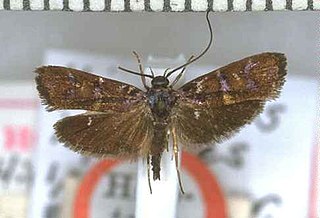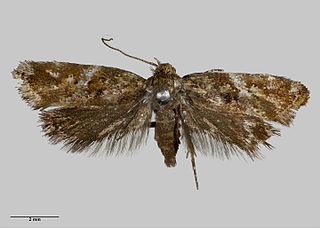Colonanthes is a genus of moths in the family Gelechiidae. It contains the species Colonanthes plectanopa, which is found in Brazil (Amazonas) and Peru.

Hexadactilia trilobata is a moth of the family Pterophoridae described by Thomas Bainbrigge Fletcher in 1910. It is found in Australia in Queensland and New Guinea.

Hierodoris iophanes is a moth of the family Oecophoridae. It was described by Edward Meyrick in 1912. This species can be distinguished from others in its genus by the purple metallic colouration as well as the blue-white mark on its forewings. It is endemic to New Zealand, where it has been recorded from Auckland to Southland. This species inhabits native forest or scrub, with the adults preferring open glades. They are known to be on the wing from November until February and fly during daylight hours, being active on hot sunny days. Larvae feed on the interior of twigs of Prumnopitys ferruginea. The twigs had evidence of oviposition scars of cicadas and the larvae were collected in October after reddish-brown frass indicated their location within the twigs.
Hypatima euplecta is a species of moth in the family Gelechiidae. It was described by Edward Meyrick in 1904. It is found in Australia, where it has been recorded from Queensland, New South Wales, Victoria and South Australia.
Hypatima isopogon is a moth in the family Gelechiidae. It was described by Edward Meyrick in 1929. It is found in southern India.
Anarsia altercata is a moth in the family Gelechiidae. It was described by Edward Meyrick in 1918. It is found in India (Bengal).
Telphusa delatrix is a moth of the family Gelechiidae. It is found in Peru.
Hapalonoma argyracta is a moth in the family Gelechiidae. It was described by Edward Meyrick in 1914. It is found in Guyana.
Molopostola rufitecta is a moth in the family Gelechiidae. It was described by Edward Meyrick in 1920. It is found in French Guiana.
Battaristis ichnota is a moth of the family Gelechiidae. It was described by Edward Meyrick in 1914. It is found in Guyana.
Compsolechia amaurota is a moth of the family Gelechiidae. It was described by Edward Meyrick in 1914. It is found in Guyana.
Compsolechia sesamodes is a moth of the family Gelechiidae. It was described by Edward Meyrick in 1922. It is found in Brazil and Peru.
Anacampsis poliombra is a moth of the family Gelechiidae. It was described by Edward Meyrick in 1922. It is found in Brazil (Amazonas).
Anacampsis peloptila is a moth of the family Gelechiidae. It was described by Edward Meyrick in 1914. It is found in Guyana.
Aristotelia paterata is a moth of the family Gelechiidae. It was described by Edward Meyrick in 1914. It is found in Guyana and Peru.
Aristotelia brochodesma is a moth of the family Gelechiidae. It was described by Edward Meyrick in 1908. It is found in Assam, India.
Taygete altivola is a moth in the family Autostichidae. It was described by Edward Meyrick in 1929. It is found in Peru.
Stenoma picrantis is a moth in the family Depressariidae. It was described by Edward Meyrick in 1930. It is found in Pará, Brazil.
Chlamydastis strabonia is a moth in the family Depressariidae. It was described by Edward Meyrick in 1930. It is found in Pará, Brazil.

Tingena eumenopa is a species of moth in the family Oecophoridae. It is endemic to New Zealand and found in the North and South Islands. The adults have been found amongst tree ferns and are on the wing in December.


